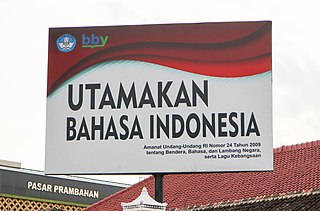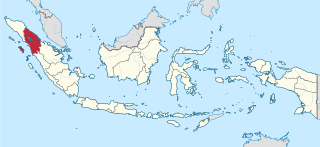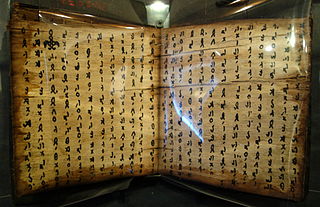Related Research Articles

Indonesian, sometimes also known simply as Bahasa in international contexts, is the official and national language of Indonesia. It is a standardized variety of Malay, an Austronesian language that has been used as a lingua franca in the multilingual Indonesian archipelago for centuries. With over 280 million inhabitants, Indonesia ranks as the fourth most populous nation globally. According to the 2020 census, over 97% of Indonesians are fluent in Indonesian, making it the largest language by number of speakers in Southeast Asia and one of the most widely spoken languages in the world. Indonesian vocabulary has been influenced by various native regional languages such as Javanese, Sundanese, Minangkabau, Balinese, Banjarese, and Buginese, as well as by foreign languages such as Arabic, Dutch, Portuguese, and English. Many borrowed words have been adapted to fit the phonetic and grammatical rules of Indonesian, enriching the language and reflecting Indonesia's diverse linguistic heritage.

Malay is an Austronesian language that is an official language of Brunei, Indonesia, Malaysia, and Singapore. It is also spoken in East Timor and southern part of Thailand. Altogether, it is spoken by 290 million people across Maritime Southeast Asia.

Medan is the capital and largest city of the Indonesian province of North Sumatra. The nearby Strait of Malacca, Port of Belawan, and Kualanamu International Airport make Medan a regional hub and multicultural metropolis, acting as a financial centre for Sumatra and a gateway to the western part of Indonesia. About 60% of the economy in North Sumatra is backed by trading, agriculture, and processing industries, including exports from its 4 million acres of palm oil plantations. The National Development Planning Agency listed Medan as one of the four main central cities in Indonesia, alongside Jakarta, Surabaya, and Makassar. In terms of population, it is the most populous city in Indonesia outside of the island of Java. Its population as of 2023 is approximately equal to the country of Moldova.

North Sumatra, also called North Sumatra Province, is a province of Indonesia located in the northern part of the island of Sumatra, just south of Aceh. Its capital and largest city is Medan on the east coast of the island. It is bordered by Aceh on the northwest and Riau and West Sumatra on the southeast, by coastlines located on the Indian Ocean to the west, and by the Strait of Malacca to the east.

In addition to its classical and modern literary form, Malay had various regional dialects established after the rise of the Srivijaya empire in Sumatra, Indonesia. Also, Malay spread through interethnic contact and trade across the south East Asia Archipelago as far as the Philippines. That contact resulted in a lingua franca that was called Bazaar Malay or low Malay and in Malay Melayu Pasar. It is generally believed that Bazaar Malay was a pidgin, influenced by contact among Malay, Hokkien, Portuguese, and Dutch traders.
Indonesian slang vernacular, or Jakarta colloquial speech is a term that subsumes various urban vernacular and non-standard styles of expression used throughout Indonesia that are not necessarily mutually intelligible. Regional slang from the capital of Jakarta, based on Betawi language, is however heavily exposed and promoted in national media, and considered the de facto Indonesian slang. Despite its direct origins, Indonesian slang often differs quite significantly in both vocabulary and grammatical structure from the most standard form of Indonesia's national language. These expressions are neither standardized nor taught in any formal establishments, but rather function in daily discourse, usually in informal settings. Several dictionaries of bahasa gaul has been published. Indonesian speakers regularly mix several regional slangs in their conversations regardless of origin, but depending on the audience and the familiarity level with the listeners.
Indonesian and Malaysian Malay are two standardised varieties of the Malay language, the former used officially in Indonesia and the latter in Brunei, Malaysia and Singapore. Both varieties are generally mutually intelligible, yet there are noticeable differences in spelling, grammar, pronunciation and vocabulary, as well as the predominant source of loanwords. The differences can range from those mutually unintelligible with one another, to those having a closer familial resemblance. The regionalised and localised varieties of Malay can become a catalyst for intercultural conflict, especially in higher education.

The Indonesian Wikipedia is the Indonesian language edition of Wikipedia. It is the fifth-fastest-growing Asian-language Wikipedia after the Japanese, Chinese, Korean, and Turkish language Wikipedias. It ranks 25th in terms of depth among Wikipedias. Its first article was written on 30 May 2003, yet its main page was created six months later on 29 November 2003.

The Mandailing people are an ethnic group in Sumatra, Indonesia that is commonly associated with the Batak people. They are found mainly in the northern section of the island of Sumatra in Indonesia. They came under the influence of the Kaum Padri who ruled the Minangkabau of Tanah Datar. As a result, the Mandailing were influenced by Muslim culture and converted to Islam. There are also a group of Mandailing in Malaysia, especially in the states of Selangor and Perak. They are closely related to the Angkola and Toba.

Jambi Malay, is a Malayic language primarily spoken by the Jambi Malay people in Jambi, Indonesia, but also spoken by migrants who have settled in Jambi. Jambi Malay is considered as a dialect of the Malay language that is mainly spoken in Jambi, but it is also used in the southern part of Riau and the northern part of South Sumatra. In Jambi, Jambi Malay has eight dialects, including the Tanjung Jabung dialect, Jambi City dialect, Muaro Jambi dialect, Batanghari dialect, Tebo dialect, Bungo dialect, Sarolangun dialect, and Merangin dialect. Jambi Malay is used as a lingua franca and for interaction among the various ethnic groups in Jambi. The differences between each dialect in Jambi Malay range from about 51 to 80 percent.

Indonesia is home to over 700 living languages spoken across its extensive archipelago. This significant linguistic variety constitutes approximately 10% of the world’s total languages, positioning Indonesia as the second most linguistically diverse nation globally, following Papua New Guinea. The majority of these languages belong to the Austronesian language family, prevalent in the western and central regions of Indonesia, including languages such as Acehnese, Sundanese, and Buginese. In contrast, the eastern regions, particularly Papua and the Maluku Islands, are home to over 270 Papuan languages, which are distinct from the Austronesian family and represent a unique linguistic heritage. The language most widely spoken as a native language is Javanese, primarily by the Javanese people in the central and eastern parts of Java Island, as well as across many other islands due to migration.
Sarawak Malay is a Malayic language native to the State of Sarawak. It is a common language used by natives of Sarawak and also as the important mother tongue for the Sarawakian Malay people.

Malay Indonesians are ethnic Malays living throughout Indonesia. They are one of the indigenous peoples of the country. Indonesian, the national language of Indonesia, is a standardized form of Riau Malay. There were numerous kingdoms associated with the Indonesian Malays along with other ethnicities in what is now Indonesia, mainly on the islands of Borneo and Sumatra. These included Srivijaya, the Melayu Kingdom, Dharmasraya, the Sultanate of Deli, the Sultanate of Siak Sri Indrapura, the Riau-Lingga Sultanate, the Sultanate of Bulungan, Pontianak Sultanate, and the Sultanate of Sambas. The 2010 census states that there are 8 million Malays in Indonesia; this number comes from the classification of Malays in East Sumatra and the coast of Kalimantan which is recognized by the Indonesian government. This classification is different from the Malaysia and Singapore census which includes all ethnic Muslims from the Indonesian archipelago as Malays.
Medan Hokkien is a local variety of Hokkien spoken amongst Chinese Indonesians in Medan, North Sumatra, Indonesia. It is the lingua franca in Medan as well as the surrounding cities in the state of North Sumatra. It is also spoken in some Medan Chinese migrant communities such as in Jakarta. Medan Hokkien is a subdialect of the Zhangzhou (漳州) Hokkien, particularly of Haicheng (海澄) subdialect. It borrows heavily from Teochew, Deli Malay and Indonesian.

Mandailing Batak or Mandailing is an Austronesian language spoken in Sumatra, the northern island of Indonesia. It is spoken mainly in Mandailing Natal Regency, North Padang Lawas Regency, Padang Lawas Regency, and eastern parts of Labuhan Batu Regency, North Labuhan Batu Regency, South Labuhan Batu Regency and northwestern parts of Riau Province. It is written using the Latin script but historically used Batak script.

The Simalungun people are an ethnic group in North Sumatra, considered one of the Batak peoples. Simalungun people live mostly in Simalungun Regency and the surrounding areas, including the city of Pematang Siantar, an autonomous city, but previously part of Simalungun Regency.

Pakpak, or Batak Dairi, is an Austronesian language of Sumatra. It is spoken in Dairi Regency, Pakpak Bharat Regency, Parlilitan district in Humbang Hasundutan Regency, Manduamas district in Central Tapanuli Regency, Subulussalam City, and Aceh Singkil Regency.

Pontianak Malay is a Malayic language primarily spoken by the Malay people in Pontianak and the surrounding areas in West Kalimantan, Indonesia. It is also widely spoken in neighboring regencies, including Kubu Raya and Mempawah, both of which were historically part of the now-dissolved Pontianak Regency. Pontianak Malay was also the primary language of the Pontianak Sultanate, a Malay state that once governed the area now known as Pontianak. In these regions, Pontianak Malay is not limited to being spoken exclusively by the Malay community. It functions as a lingua franca alongside standard Indonesian, enabling communication among the diverse ethnic groups in the area. However, the use of Pontianak Malay faces a slight threat as many speakers are gradually shifting to Indonesian, the national language.

Deli Malays is a sub-ethnic group of Malays native to the eastern coast of North Sumatra, particularly in the Deli Serdang and Medan. The Deli culture began with the Sultanate of Deli, an Islamic kingdom established in North Sumatra from 1632 to 1946. Deli Malays are known for their famous pantoum art until today.

Malay has a long history as a lingua franca in the Malay Archipelago which currently includes Indonesia, Philippines, Malaysia, Brunei Darussalam, Singapore, East Timor, and the southern part of Thailand. This geographical variation, which then spread widely even to South Africa, finally led to the formation of a Malay language cluster which spread and had differences due to geographical conditions. The following is a list of Malay dialects and varieties summarized in one article.
References
Notes
- ↑ The number of speakers is adjusted to the population in Medan City in 2023. [1]
Footnotes
- ↑ "Kota Medan Dalam Angka 2023" (PDF) (in Indonesian). BPS Kota Medan. 28 February 2023. p. 56. Retrieved 15 April 2023.
- ↑ "Kata-kata 'aneh' ini cuma orang Medan yang tahu artinya". merdeka.com. Retrieved 2020-09-30.
- ↑ Nefan (2020-07-01). "Bahasa Medan Bukan Batak, Ini Contohnya". minews.id (in Indonesian). Retrieved 2020-09-30.[ permanent dead link ]
- ↑ SeMedan.com (2016-02-10). "Kamus Istilah Bahasa Medan, Lengkap Terbaru Unik Lucu (1)". SeMedan.com (in Indonesian). Retrieved 2020-09-30.
- 1 2 3 4 5 Purba, Amran (December 2007). "DIALEK MEDAN: KOSAKATA DAN LAFALNYA". www.badanbahasa.kemendikbud.go.id (in Indonesian). Retrieved 2 October 2020.
- ↑ "Berita Bahasa Medan Terbaru Hari Ini - Grid.ID". www.grid.id (in Indonesian). Retrieved 2020-09-30.
- ↑ Molana, Datuk Haris. "Surat Lamaran Kerja 'Anak Medan' Viral, Begini Analisis Gaya Bahasanya". detiknews (in Indonesian). Retrieved 2020-09-30.
- ↑ "Yuk Belajar Bahasa Medan Ala Warganet TikTok | INDOZONE SUMUT". indozone.id (in Indonesian). 2020-07-18. Retrieved 2020-09-30.
- ↑ Molana, Datuk Haris. "Kenapa Orang Medan Suka Cakap 'Apa-Biar Gak Itu Kali'? Ini Penjelasannya". detiknews (in Indonesian). Retrieved 2020-10-02.